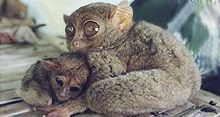Philippine tarsier
[3] The Philippine tarsier is known as mawumag in Cebuano and other Visayan languages, and magô in Waray,[4][5] It is also known as mamag, magau, malmag, and magatilok-iok.[14] The large membranous ears are mobile,[15] appearing to be almost constantly moving, allowing the tarsier to hear any movement.[13] Its long digits are tipped with rounded pads that allow C. syrichta to cling easily to trees and to grip almost any surface.[18] Its habitat also includes tropical rainforest with dense vegetation and trees that offer it protection such as tall grasses, bushes, and bamboo shoots.[21] Besides human hunters, feral cats banished from nearby communities are the species' main predators, though some large birds are known to prey on it, as well.[22] Because of its nocturnal and arboreal habits, the Philippine tarsier is most likely to fall prey to owls, or to small carnivores which it can encounter in its canopy homes.During the day, it sleeps in dark hollows close to the ground, near tree trunks and shrubs deep in the impenetrable bushes and forests.On September 13, 1991, the Department of Environment and Natural Resources issued DENR Administrative Order Number 48 (DAO 48), which also listed the Philippine tarsier as endangered.[1] This classification is based on an estimated significant decline over the last three generations (about 20 years), but less than 30%, due to habitat loss and because of poaching for the pet trade.Run by the Philippine Tarsier Foundation, it has a visitor centre and habitat preserve with an area of 7,000 m2 (75,000 sq ft) in a natural forest.[23][30] For the past 45 million years, tarsiers have inhabited rainforests around the world, but now they exist on only a few islands in the Philippines, Borneo, and Indonesia.[31] Due to the quickly growing human population, which causes more and more forests to be converted to farmland, housing areas, and roads, the place where the Philippine tarsier can live its secluded life is disappearing.Indiscriminate and illegal logging, cutting of trees for firewood, kaingin or slash and burn method of agriculture, and human urbanization have encroached on the habitats of the tarsier.[32] Paradoxically, indigenous superstition, coupled with relatively thick rainforest, particularly in Sarangani province, has apparently preserved this endangered species.Indigenous tribes leave the Philippine tarsiers in the wild because they fear that these animals could bring bad luck.[21] Tarsiers in the Philippines have been sought out as pets or sold for trade, despite their low survival rate outside of their natural habitat, where they feed on live insects.Because the tarsier is often shy and nervous, many activities associated with captivity (such as camera flashes, being touched, and being kept in an enclosure) stresses the animal.The law provided for the conservation and protection of wildlife resources and their habitats, including the Philippine tarsier, and its inclusion as a flagship species.In partnership with local groups and government, ESI established the tarsier trail including a viewpoint on habitat.






Conservation statusNear ThreatenedIUCN 3.1Scientific classificationEukaryotaAnimaliaChordataMammaliaPrimatesHaplorhiniTarsiidaeGrovesBinomial nameLinnaeusSynonymsCebuanoVisayan languagestarsierendemicPhilippinestarsusTarsiusMaripipi IslandSiargao IslandBasilan IslandDinagat IslandSaranganiCephalopachusNiemitzpygmy tarsierdentitiondental formulainsectivorouscricketsgrasshopperstropical rainforestbamboosolitaryferal catsnocturnalarborealmonogamousthrough a scentterritorygestationestrous cyclemating plugendangeredDepartment of Environment and Natural Resourceslower riskconservation-dependentdata deficientextinctionU.S. ESACorellaPhilippine Tarsier Foundationillegal loggingslash and burnIndigenousLoboc, BoholsanctuariesfaunalspeciesIUCN Red List of Threatened SpeciesWayback MachineGroves, C. P.Wilson, D. E.WikispeciesEnsemblUCSC Genome BrowserCarlitoHorsfield's tarsier (Ce. bancanus)Spectral tarsier (T. tarsier)Dian's tarsier (T. dentatus)Lariang tarsier (T. lariang)Peleng tarsier (T. pelengensis)Gursky's spectral tarsier (T. spectrumgurskyae)Jatna's tarsier (T. supriatnai)Sangihe tarsier (T. sangirensis)Pygmy tarsier (T. pumilus)Siau Island tarsier (T. tumpara)Wallace's tarsier (T. wallacei)Makassar tarsier (T. fuscus)Niemitz's tarsier (T. niemitzi)OmomyidaeAltaniusAltiatlasiusBownomomysNecrolemurAnaptomorphinaeTeilhardinaChipetaiaNesomomysRooneyiaShoshoniusTarsiiformesArchicebusAfrotarsiidaeSimiiformesNosmipsPhileosimiasAfrasiaAfrotarsiusEosimiidaeEosimiasAmphipithecidaeAmphipithecusGanleaParapithecoideaArsinoeaBiretiaProteopithecidaeSerapiaParapithecidaeApidiumParapithecusQatraniaPlatyrrhiniCanaanimicoBranisellaLagonimicoAotidaeTremacebusPitheciidaeAntillothrixCacajao